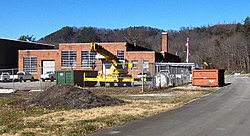Calderwood Hydroelectric Development | |
 Calderwood Dam service building | |
| Location | 314 Growdon Boulevard |
|---|---|
| Nearest city | Maryville, Tennessee |
| Coordinates | 35°29′56″N 83°59′15″W / 35.49889°N 83.98750°W |
| Area | 195 acres (79 ha)[1] |
| Built | 1930–1953 |
| Architect | A.V. Karpov, Tapoco Inc. |
| Architectural style | Colonial Revival |
| NRHP reference No. | 04000545 |
| Added to NRHP | May 24, 2004 |
Calderwood was a community once located along the Little Tennessee River in Blount County, Tennessee, United States. Established in 1912 as a base for the Aluminum Company of America's Little Tennessee Valley hydroelectric development operations, the community continued to house construction personnel and dam maintenance personnel for nearby Calderwood Dam until the 1960s. Although the community's houses were razed after its abandonment, three buildings located in the community— the Calderwood Dam service building, the Calderwood School, and a Quonset hut used as a theater— were included in a supplementary listing for Calderwood Dam on the National Register of Historic Places in 2004.[1]
Alcoa began developing the Little Tennessee Valley in 1909 to provide the ample amounts of electricity necessary to power its planned aluminum smelting operations in Blount County. Under the leadership of Alcoa engineer Isaac Glidden Calderwood (1871–1941), three dams— Cheoah (1919), Santeetlah (1928), and Calderwood (1930)— were completed in a remote section of the valley along the Tennessee-North Carolina border. The community of Calderwood was initially known as "Alcoa," but was renamed in I. G. Calderwood's honor after the company reapplied the name "Alcoa" to its main company town in northern Blount County.[2]
- ^ a b Philip Thomason and Teresa Douglas, National Register of Historic Places Continuation Sheet - Supplementary Listing Record for Calderwood Dam, 14 October 2003.
- ^ Russell Parker, "Alcoa, Tennessee: The Early Years, 1919–1939." East Tennessee Historical Society Publications Vol. 48 (1976), p. 85.

